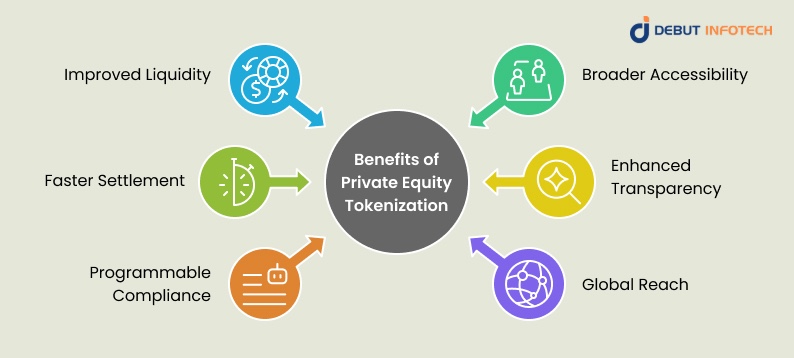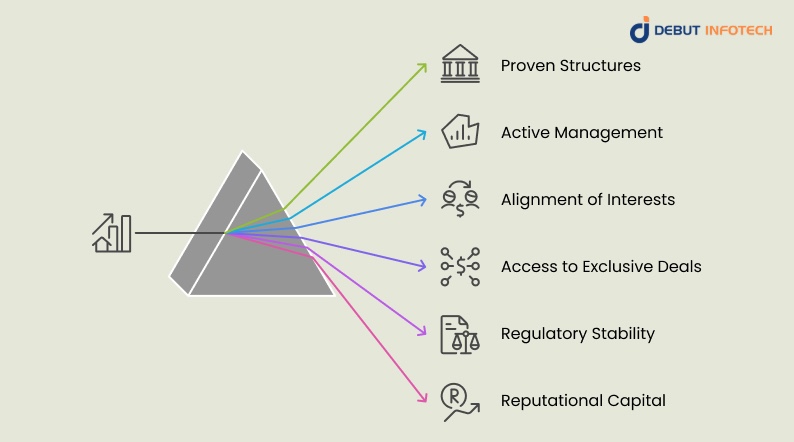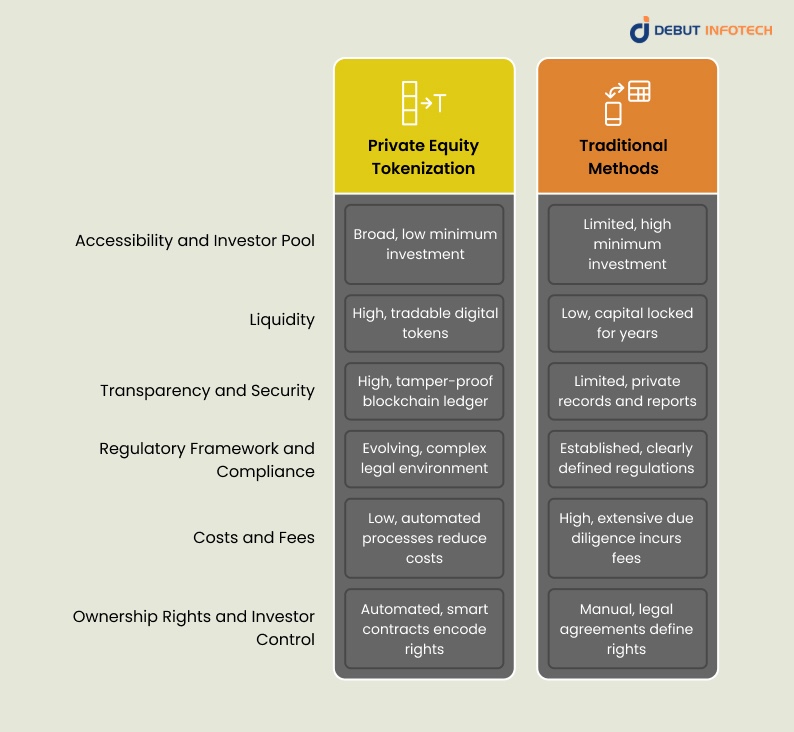Table of Contents
Home / Blog / Tokenization
Equity Tokenization vs. Traditional Methods
July 9, 2025

July 9, 2025
Equity Tokenization vs. Traditional Methods has become a defining debate in modern finance. Tokenization uses blockchain to digitize private equity shares, enabling fractional ownership and faster settlements.
Per the World Economic Forum, by 2027, around 10% of the world’s GDP—equivalent to roughly $24 trillion—is projected to be stored and transacted using tokenized assets.
In contrast, traditional private equity, valued at about $8 trillion globally as reported by the Bank of England, relies on exclusive investor pools, lengthy holding periods, and manual administration.
While tokenization promises transparency, liquidity, and inclusivity, it faces regulatory uncertainties and cybersecurity concerns. Conversely, conventional methods offer stability and proven frameworks but restrict access and flexibility. This guide examines the core differences, benefits, and trade-offs between these two approaches, equipping investors to navigate a growing market.
Ditch the Paper Trails
Escape old-school equity hassles. Let our blockchain experts show you how tokenization unlocks fast, secure ownership transfers with zero paperwork drama.
What is Private Equity Tokenization?
Private equity tokenization refers to the process of representing ownership interests in private companies as digital tokens recorded on a blockchain. These tokens are programmable assets that encapsulate legal rights, such as dividend entitlements and voting privileges. By leveraging distributed ledger technology, tokenization seeks to modernize the issuance, transfer, and management of equity stakes.
Typically, tokens are created through smart contracts, which enforce compliance with regulatory standards and contractual obligations automatically. This approach contrasts with traditional private equity, which relies on manual record-keeping, paper certificates, and intermediated transactions.
Benefits of Private Equity Tokenization

1. Improved Liquidity
Tokenization introduces secondary markets where private equity tokens can be traded peer-to-peer or via regulated exchanges. This reduces long lock-in periods and enables investors to sell their stakes more easily, which is traditionally not possible until an exit event, such as an IPO or acquisition. It also fosters portfolio rebalancing and encourages more active investor participation.
2. Broader Accessibility
By enabling fractional ownership, tokenized equity drastically lowers the minimum capital required to invest. This opens private equity opportunities to a larger investor base, including those previously excluded due to high thresholds. The result is a more inclusive market where high-growth investments are no longer limited to institutions or ultra-high-net-worth individuals.
3. Faster Settlement
Settlement in traditional private equity can take weeks due to legal review and administrative bottlenecks. Tokenization platforms automate these processes through smart contracts, allowing instant or near-instant settlement. This efficiency not only accelerates deal execution but also reduces the risks associated with delayed transfers and manual processing errors.
4. Enhanced Transparency
Every transaction on a blockchain is time-stamped, immutable, and publicly verifiable. This creates a comprehensive audit trail, minimizing the possibility of record tampering or disputes. Investors and regulators gain clearer insights into asset flows. At the same time, issuers can foster greater confidence through built-in transparency and accountability.
5. Programmable Compliance
Smart contracts, enabled by robust token development protocols, are coded to enforce regulatory restrictions automatically, such as investor eligibility, lock-up periods, and transfer limits. This reduces reliance on intermediaries and ensures that compliance measures are applied consistently and efficiently. The automation minimizes human error and helps issuers stay aligned with regulatory obligations across jurisdictions.
6. Global Reach
Blockchain-based platforms aren’t confined by national borders. Private equity tokens can be offered globally, attracting investors from various regions without the logistical complexity of traditional fundraising. This widens the capital-raising potential, promotes international diversification, and enables issuers to tap into markets that were previously inaccessible or too costly to reach.
Drawbacks of Private Equity Tokenization
1. Regulatory Uncertainty
Many countries lack specific guidelines for tokenized securities, leaving issuers and investors in regulatory limbo. This uncertainty creates compliance risks and can delay platform adoption. Tokenization companies may be required to navigate overlapping or conflicting laws. Without established frameworks, regulatory enforcement can be inconsistent, thereby increasing the overall risk profile of these investments.
2. Market Adoption Challenges
Although the technology is promising, widespread adoption remains limited. Institutional investors, custodians, and fund administrators remain cautious about entering this space due to unfamiliarity, risk concerns, and a lack of infrastructure. Until these stakeholders adopt tokenization en masse, liquidity and deal flow will remain subdued, limiting their full impact.
3. Cybersecurity Concerns
While blockchain is inherently secure, the surrounding infrastructure—such as wallets, smart contracts, and custodians—can be vulnerable. Hacks, phishing attacks, or flaws in smart contract code could lead to the loss of assets. Ensuring end-to-end security requires rigorous audits, robust cybersecurity protocols, and effective user education, which not all platforms or investors may be equipped to implement.
4. Technical Complexity
Tokenization introduces a learning curve for investors, managers, and platforms alike. Understanding blockchain mechanics, managing cryptographic keys, and dealing with custody solutions can be daunting. This complexity may deter traditional investors or require significant training and onboarding, potentially slowing adoption and increasing operational risks during the implementation process.
5. Valuation Volatility
When tokenized private equity is traded on secondary markets, it may be exposed to speculative trading behaviors that can lead to price fluctuations. This can distort the underlying value of the asset and deter long-term investors. The introduction of public-like volatility in traditionally stable, long-horizon investments creates an unfamiliar and sometimes unsettling dynamic.
What is Traditional Private Equity?
Traditional private equity involves investment in non-publicly traded companies through structured funds managed by general partners. Investors, or limited partners, commit capital to these funds, which then acquire equity stakes in target firms.
The process typically encompasses due diligence, negotiated terms, and a multi-year investment horizon, aimed at creating value through operational improvements or strategic exits. Ownership records are maintained through legal documentation and manual registry updates. Transactions are governed by contractual agreements, and liquidity is generally constrained until an exit event, such as a merger, acquisition, or IPO, occurs.
Benefits of Traditional Private Equity

1. Proven Structures
Traditional private equity operates within time-tested legal and financial frameworks. Investors understand how funds are structured, returns are distributed, and risks are managed. With a long history of regulatory oversight and professional norms, these mechanisms provide consistency and confidence, particularly for institutional capital seeking mature and well-defined investment strategies.
2. Active Management
General partners (GPs) typically take an operational role in portfolio companies, helping improve governance, restructure operations, or accelerate growth. Their deep industry expertise and hands-on approach often lead to substantial performance enhancements that passive investing cannot offer. This direct involvement is a key driver of alpha in traditional private equity.
3. Alignment of Interests
Carried interest and performance fees ensure that fund managers are incentivized to drive returns. Since GPs earn a portion of profits only after meeting hurdle rates, their goals are closely tied to those of investors. This alignment fosters accountability and encourages long-term, sustainable decision-making within portfolio companies.
4. Access to Exclusive Deals
Established private equity firms often gain access to proprietary or off-market deals unavailable to the broader investment community. Their networks, reputation, and deal sourcing strategies position them to negotiate attractive terms and uncover high-potential companies early in the investment lifecycle, offering a competitive edge.
5. Regulatory Stability
Traditional private equity benefits from decades of clearly established legal precedents and well-understood regulatory oversight. This predictability reduces compliance uncertainty, making it easier for institutional investors to navigate fund structures, reporting standards, and disclosure requirements with confidence and efficiency.
6. Reputational Capital
Established private equity firms have built trust over the years or decades. Their track record, brand recognition, and historical performance data help reassure investors. This credibility often leads to repeat capital commitments, better deal access, and smoother fund launches, especially in competitive fundraising environments where trust and a proven track record matter.
Drawbacks of Traditional Private Equity
1. Limited Liquidity
Private equity funds typically impose lock-up periods ranging from 7 to 12 years, during which investors are prohibited from redeeming their capital. Secondary sales are rare and heavily discounted. This long-term illiquidity makes private equity less suitable for investors who require flexible access to their funds or wish to respond to market changes.
2. High Minimum Commitments
Entry into traditional private equity funds often requires commitments of \$250,000 or more, making them inaccessible to most retail investors. These high thresholds restrict participation to institutions and ultra-high-net-worth individuals, effectively excluding broader capital pools and reinforcing a system of exclusivity in alternative investments.
3. Opaque Valuation
Valuations in traditional private equity are often based on periodic internal assessments rather than real-time market feedback. This lack of transparency can obscure a portfolio’s actual worth and hinder accurate performance monitoring. Investors must rely on quarterly reports and discretionary methodologies that may not reflect current market conditions.
4. Complex Administration
Traditional private equity structures involve extensive documentation, capital calls, distribution schedules, and tax reporting obligations. These manual processes require the involvement of legal counsel, administrators, and accountants, all of which add to the cost and complexity. This overhead can be a deterrent for smaller investors or managers seeking operational efficiency.
5. Lengthy Settlement
Transferring ownership of private equity interests involves obtaining legal approvals, navigating right-of-first-refusal processes, and completing extensive documentation, which can result in weeks of settlement time. This administrative delay contrasts sharply with tokenized models, where ownership can be transferred near-instantly. The slow pace of settlements in traditional methods limits flexibility and responsiveness in portfolio management.
Private Equity Tokenization vs. Traditional Methods: Differences

1. Accessibility and Investor Pool
In the debate of private equity tokenization vs. traditional methods, private equity tokenization enables fractional ownership and lowers minimum investments to as little as a few hundred dollars, broadening access to accredited investors globally. Digital platforms can onboard participants efficiently, using blockchain identity verification to meet compliance requirements without traditional paperwork. This inclusivity attracts a diverse investor pool beyond institutional capital.
Traditional private equity generally requires large commitments—often $250,000 or more—which restrict participation to institutions and wealthy individuals.
Fundraising processes are lengthy, involving extensive due diligence, relationship building, and regulatory vetting. This exclusivity preserves a sense of prestige but limits democratization and diversification among investors.
Example: A tokenized platform enables small investors to purchase $500 stakes in a company. In contrast, a traditional fund requires a minimum commitment of $250,000 for participation.
2. Liquidity
Tokenized equity transforms traditionally illiquid stakes into tradable digital tokens. On real estate tokenization platforms, Investors can access secondary markets or peer-to-peer exchanges to exit positions at any time, subject to regulatory restrictions coded into smart contracts. This liquidity empowers investors to rebalance portfolios and access capital without waiting for a full exit event.
In contrast, traditional private equity locks capital for 7–12 years, with redemption typically only possible after a sale, IPO, or buyout. Secondary transactions are uncommon and often require manager approval. This lack of liquidity is a key barrier for many investors who prefer flexible capital allocation.
Example: An investor trades tokens for cash within a day; in a traditional fund, they must wait years for an exit to access liquidity.
3. Transparency and Security
Blockchain technology provides a tamper-proof, auditable ledger that records all transactions and ownership transfers accurately and securely. Investors can verify holdings and transaction history in real time, reducing disputes and enhancing trust. Smart contracts automatically enforce permissions, enhancing security over traditional document-based processes that are vulnerable to errors and fraud.
Traditional private equity depends on private records, quarterly reports, and subjective valuations, which can limit visibility into fund performance. Paper documentation and manual updates create risk for inaccuracies, disputes, and inconsistent reporting. Security relies heavily on intermediaries maintaining robust internal controls.
Example: Equity tokenization displays all transfers publicly on-chain, whereas traditional funds provide quarterly PDFs and internal spreadsheets that investors cannot verify in real-time.
4. Regulatory Framework and Compliance
In tokenization vs. Traditional asset management, tokenization operates in a complex, evolving legal environment where securities laws and blockchain regulations intersect. Issuers must navigate jurisdictional rules, ensure compliance with KYC/AML requirements, and integrate legal agreements into smart contracts. This creates additional complexity but can also lead to the development of automated, efficient compliance frameworks over time.
Traditional private equity benefits from decades of clearly defined regulations, legal precedents, and standardized compliance practices. Fund managers and investors generally know the expectations, timelines, and disclosure requirements, making compliance predictable and well-established, albeit slower to execute.
Example: A tokenization platform must adapt to evolving digital asset laws, whereas traditional funds follow stable, decades-old regulations that require manual compliance checks.
5. Costs and Fees
Tokenization can significantly lower costs by automating processes such as record-keeping, ownership transfers, and compliance reporting. Reduced reliance on intermediaries and manual documentation helps issuers save on legal, administrative, and custodial fees, potentially leading to improved net returns for investors over time.
Traditional private equity involves extensive due diligence, legal negotiations, and ongoing fund administration. These processes incur high fees that are passed to investors through management fees and transaction costs. Manual workflows are slower and more expensive, especially when funds manage complex structures across jurisdictions.
Example: A tokenized deal costs 40% less by automating settlement; a traditional transaction requires lawyers and administrators to bill thousands of dollars in additional fees.
6. Ownership Rights and Investor Control
Smart contracts in tokenized equity encode ownership rights, voting privileges, and distribution rules directly into the token, thereby eliminating the need for intermediaries. This automation ensures rights are applied consistently and transparently while reducing reliance on intermediaries to enforce agreements. Digital execution can streamline governance processes, improving investor confidence in fair treatment.
Traditional private equity relies on detailed legal agreements, side letters, and manual administration to define and enforce ownership rights.
Control rights, voting thresholds, and profit distribution are managed through contract interpretation and human oversight, which can lead to delays or inconsistencies if disputes arise.
Example: Token holders vote instantly via blockchain; traditional investors wait weeks for manual tallying and legal verification of governance decisions.
Related Read: What is Tokenization
Liquid Assets, No Waiting
Turn illiquid private equity into tradable tokens. Say goodbye to lock-up periods and hello to instant liquidity, your investors will love.
Conclusion
In the debate of Equity Tokenization vs. Traditional Methods, each model presents compelling advantages and unique risks. Tokenization modernizes private equity by offering broader access, greater liquidity, and transparent processes.
However, regulatory clarity and adoption remain works in progress. Traditional private equity offers tested structures and long-term value, but it limits investor participation and flexibility. Understanding these differences empowers investors to align strategies with their goals. As markets evolve, striking a balance between innovation and stability will be crucial for informed investment decisions.
FAQs
A. Tokenized equity means you take ownership in a company and turn it into digital tokens on a blockchain. Each token represents a piece of the company’s shares. It’s basically a new way to issue, track, and trade equity securely and efficiently online.
A. Shares are traditional ownership units recorded in company ledgers or by brokers. Tokenization turns those shares into blockchain-based tokens. So you still own equity, but instead of paper certificates or records in a database, you hold digital tokens that are easier to trade and manage.
A. Digitalization involves converting paper records or processes into digital form, such as PDFs or spreadsheets. Tokenization takes it a step further by assigning ownership rights or assets to a blockchain as unique tokens. So, tokenization isn’t just digital; it’s about secure, programmable assets that can be transferred easily.
A. One example is Overstock’s tZERO token. Investors bought these tokens, which represent shares in tZERO. Instead of holding traditional stock certificates, they held blockchain tokens that track ownership and can be traded on approved digital exchanges, with all transactions securely recorded on the blockchain.
A. In private equity, tokenization means taking stakes in private companies or funds and converting them into digital tokens. This makes it easier to split ownership into small parts, improve liquidity, and allow more people to invest or trade pieces of private equity than before.
Talk With Our Expert
USA
2102 Linden LN, Palatine, IL 60067
+1-708-515-4004
info@debutinfotech.com
UK
Debut Infotech Pvt Ltd
7 Pound Close, Yarnton, Oxfordshire, OX51QG
+44-770-304-0079
info@debutinfotech.com
Canada
Debut Infotech Pvt Ltd
326 Parkvale Drive, Kitchener, ON N2R1Y7
+1-708-515-4004
info@debutinfotech.com
INDIA
Debut Infotech Pvt Ltd
Sector 101-A, Plot No: I-42, IT City Rd, JLPL Industrial Area, Mohali, PB 140306
9888402396
info@debutinfotech.com





Leave a Comment